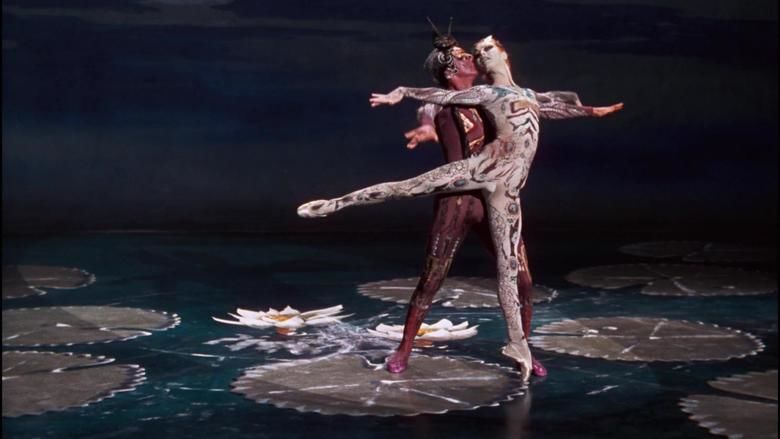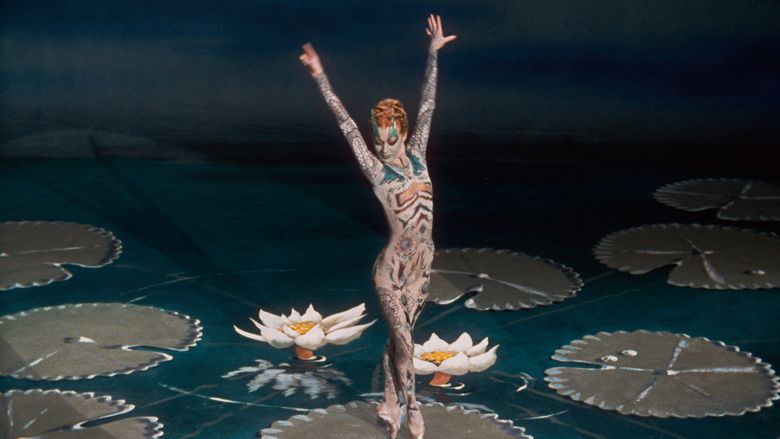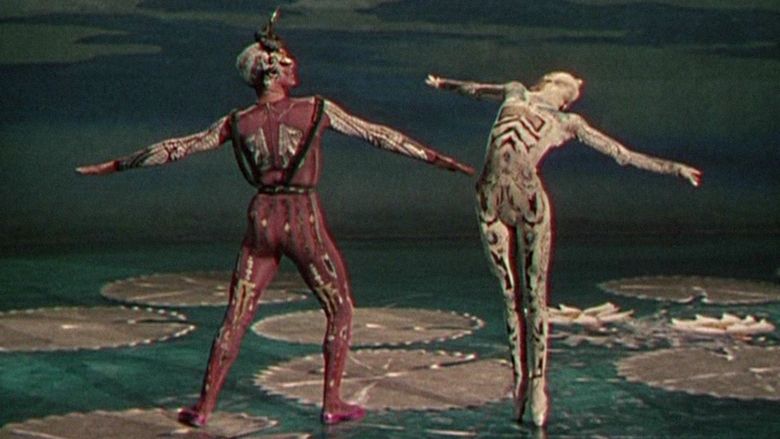The Tales of Hoffmann (film)
8.2 /10 1 Votes
88% Rotten Tomatoes Genre Fantasy, Music, Musical Duration Country United Kingdom | 7.4/10 IMDb Music director Jacques Offenbach Language English | |||||||||||||||||||||||||||||||||
 | ||||||||||||||||||||||||||||||||||
Director Michael Powell
Emeric Pressburger Writer E. T. A. Hoffmann , Jules Barbier Release date 4 April 1951 (US trade)
17 May 1951 (UK trade)
26 November 1951 (UK release)
13 June 1952 (US release)
April 2015 (4K restoration) Initial release April 4, 1951 (New York City) Directors Michael Powell, Emeric Pressburger Screenplay Michael Powell, Emeric Pressburger Cast Moira Shearer (Stella / Olympia), Ludmilla Tchérina (Giulietta), Pamela Brown (Niklaus), Léonide Massine (Spalanzani / Schlemil / Franz), Ann Ayars (Antonia), Robert Helpmann (Lindorf / Coppelius / Dapertutto / Dr. Miracle)Similar movies Black Swan , Source Code , Beetlejuice , Labyrinth , The Girl Who Leapt Through Time , Mr. Nobody Tagline You Will Never See Anything Finer On The Screen! | ||||||||||||||||||||||||||||||||||
The tales of hoffmann official hd trailer
The Tales of Hoffmann is a 1951 British Technicolor film adaptation of Jacques Offenbach's opera The Tales of Hoffmann, written, produced and directed by the team of Michael Powell and Emeric Pressburger working under the umbrella of their production company, The Archers.
Contents
- The tales of hoffmann official hd trailer
- The tales of hoffmann 1951 clip
- Plot
- Adaptation
- Production
- Critical reception
- Accolades
- Soundtrack
- 2015 re release
- The tales of hoffmann 1951 the tale of giulietta
- References

The opera film stars Robert Rounseville, Moira Shearer, Robert Helpmann and Léonide Massine, and features Pamela Brown, Ludmilla Tchérina and Ann Ayars. Only Rounseville and Ayars sang their own roles.

It uses a soundtrack recorded for the film conducted by Sir Thomas Beecham; principal singers apart from Rounseville and Ayars were Dorothy Bond, Margherita Grandi, Monica Sinclair and Bruce Dargavel; the Royal Philharmonic Orchestra plays. The film's production team includes cinematographer Christopher Challis and production and costume designer Hein Heckroth, who was nominated for two 1952 Academy Awards for his work.

The tales of hoffmann 1951 clip
Plot

Adaptation
Though the original French libretto is presented in English translation, the film is relatively faithful to the traditional adaptations of Offenbach's last opera, and incorporates his unfinished score with the thread of the plot. However, certain important changes were made in the process of adapting the story to film:
Production
In the later years of their partnership, Powell became interested in what he termed "a composed film", a marriage of image to operatic music. The finale of Black Narcissus and the ballet sequence of The Red Shoes were earlier steps toward his goal.
The Tales of Hoffmann is an achievement of this ideal, as the entire opera was pre-recorded to create the soundtrack, and the movie was edited to the rhythms of the music. The production is completely without dialogue and, with the exception of Robert Rounseville and Ann Ayars, none of the actors did their own singing. Some of the singers had established careers in Britain at the time. Grahame Clifford, for example, had been a leading comedian with the D'Oyly Carte Opera Company for several years, and Monica Sinclair was fast becoming an audience favourite at Covent Garden; she would later become one of the company's most popular artists of the next two decades. The acting (especially by Helpmann) is highly stylised and similar to that of the silent film era.
Each tale is marked by its own individual primary colour, denoting its theme. "The Tale of Olympia", set in Paris, has yellow contours highlighting the farcical nature and tone of the first act. "The Tale of Giulietta" is a hellish depiction of Venice, where dark colours, especially red, are used. The final tale, set in Greece, uses different shades of blue, alluding to its sad nature. The set design is deliberately made to look artificial with the costumes similarly stylised. The opening scene of the "Tale of Giulietta" (where Giulietta performs the "Barcarolle", the most famous theme of the opera) is staged on a gondola which moves through deliberately artificial Venetian canals, although it does not seem to actually move on the water.
The Tales of Hoffmann was in production from 1–16 July 1950 at Shepperton Studios in Shepperton, Surrey, in the UK
Critical reception
Following its world premiere in New York City, Bosley Crowther of The New York Times wrote:
[D]espite its opulence, coupled with a brilliant rendering of the score by the Royal Philharmonic Orchestra under Sir Thomas Beecham's bristling baton and some masterly singing of the libretto (in English) by a host of vocal cords, this film version of the opera is, in toto, a vastly wearying show. And that is because it sates the senses without striking any real dramatic fire ... The inevitable question about this picture is how close does it come to matching the beauty and excitement of the same producers [sic] The Red Shoes? Although the two films are basically different, a comparison is fair to this extent: The Red Shoes had warmth and vitality, Tales of Hoffmann is splendid and cold.
Reportedly, Cecil B. DeMille sent a letter to Powell and Pressburger, saying, "For the first time in my life, I was treated to Grand Opera where the beauty, power and scope of the music was equally matched by the visual presentation."
For the 2002 Sight & Sound poll, George A. Romero called it his "favourite film of all time; the movie that made me want to make movies". Three years earlier, Romero had introduced the film as part of the "Dialogues: Talking with Pictures" programme at the 1999 Toronto International Film Festival. Romero later taped an interview for the Criterion Collection edition of the film, discussing his love of the film and its influence on his career. Additionally, Martin Scorsese, an ardent fan of Powell and Pressburger, provides an audio commentary track on the Criterion edition.
In a book on the British cinema, André Bazin is quoted as saying:
The cinema thus creates here a new artistic monster: the best legs adorned by the best voice. Not only is opera liberated from its material constraints but also from its human limitations. Lastly, dance itself is renewed by the photography and the editing, which allows a kind of choreography of the second degree where the rhythm of the dance is served by that of the cinema.
Accolades
At the 24th Academy Awards, The Tales of Hoffmann received two nominations, both for Hein Heckroth, for Best Art Direction-Set Decoration, Color and Best Costume Design, Color; the awards in both cases went to the crew of An American in Paris.
Powell and Pressburger were nominated for the Grand Prize of the 1951 Cannes Film Festival, and won the Exceptional Prize. They also won the Silver Bear award for "Best Musical" at the 1st Berlin International Film Festival.
Soundtrack
The soundtrack was recorded at Shepperton Studios between May and September 1950, conducted by Sir Thomas Beecham. Decca obtained permission from London Films to release the soundtrack on LP. In response, Beecham sued: he had not approved the release, because the soundtrack did not truly represent his interpretation of the opera, due to the changes made for the film. On 20 March 1951 he failed to obtain a High Court injunction to prevent the release, but received assurances that it would be clearly labelled as taken from the soundtrack.
2015 re-release
In March 2015, the 4K restoration of the film, produced by Martin Scorsese's The Film Foundation, the British Film Institute, and Studiocanal, was released in the U.S. by Rialto Pictures. The restored version runs 136 minutes, including a final credits sequence of all the performers and singers, not seen in any previous releases.
The tales of hoffmann 1951 the tale of giulietta
References
The Tales of Hoffmann (film) WikipediaThe Tales of Hoffmann (film) IMDbThe Tales of Hoffmann (film) Rotten TomatoesThe Tales of Hoffmann (film) themoviedb.org
